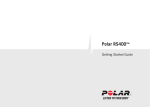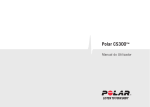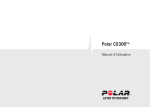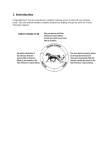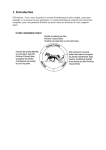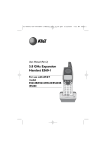Download Polar CS400 Getting Started Guide
Transcript
ENGLISH ENGLISH ENGLISH Table of Contents 1. CYCLING COMPUTER COMPONENTS .......... 3 5. AFTER TRAINING ............................. 14 2. GETTING STARTED ............................ 4 Measuring Wheel Size........................ 4 Basic Settings ................................. 6 Menu Structure ............................... 8 6. CUSTOMER SERVICE INFORMATION ......... 15 Care and Maintenance....................... 15 Caring of Your Product ...................15 Service .....................................17 Changing Batteries........................17 Precautions .................................. 20 Interference During Exercise ............20 Minimizing Risks When Exercising......21 Technical Specifications .................... 23 Limited International Polar Guarantee ...... 26 Polar Disclaimer ............................. 28 3. PREPARE FOR TRAINING ...................... 9 Bike Settings .................................. 9 Installation ................................... 10 Using an Accessory With Your CS600 Cycling Computer ..................................... 10 Wear the Transmitter ........................ 11 4. RECORD TRAINING ........................... 12 Start Training................................. 12 ENGLISH 1. CYCLING COMPUTER COMPONENTS Congratulations! You have purchased a complete training system to tailor-fit your training needs. For complete instructions on your cycling computer, consult the User Manual. 1. 2. Polar CS400 / CS600 Cycling Computer: Cycling and exercise data are recorded and displayed during exercise. Polar WearLink® 31 (Polar CS400) / WearLink® W.I.N.D. (Polar CS600) Coded Transmitter: The transmitter sends the heart rate signal to the cycling computer. The transmitter consists of a connector and a strap. 3. Polar Bike Mount™: Secure the bike mount to your bike and attach the cycling computer to it. 4. Polar Speed Sensor™ (CS400) / Speed Sensor™ W.I.N.D. (Polar CS600): A wireless speed sensor measuring speed and distance during cycling. 5. Optional Polar Cadence Sensor™ (CS400) / Cadence Sensor™ W.I.N.D. (CS600): A wireless cadence sensor measuring the speed at which you turn the cranks of your bicycle, expressed in revolutions per minute (rpm). 6. Optional Power Output Sensor™ W.I.N.D. (CS600): A sensor measuring average and maximum cadence, power output, and pedaling index, as well as left/right pedaling balance. 7. CD-ROM: Including Polar ProTrainer 5™ software and a complete User Manual to help you make the most out of your cycling computer. Cycling Computer Components 3 ENGLISH 2. GETTING STARTED Measuring Wheel Size Before activating your cycling computer, measure the wheel size of your bicycle. Wheel size settings are a prerequisite for correct cycling information. There are two ways of determining the wheel size of your bike: Method 1 Look for the diameter in inches or in ETRTO printed on the wheel. Match it to the wheel size in millimeters in the right column of the ETRTO chart on the following page. Wheel sizes on the chart are advisory as wheel size depends on the wheel type and air pressure. 4 Getting started Method 2 Measure the wheel manually for the most accurate result. Use the valve to mark the point where the wheel touches the ground. Draw a line on the ground to mark that point. Move your bike forward on a flat surface for one complete rotation. The tire should be perpendicular to the ground. Draw another line on the ground at the valve to mark a full rotation. Measure the distance between the two lines. Subtract 4 mm to account for your weight on the bike to get your wheel circumference. Enter this value in the cycling computer. ENGLISH ETRTO Wheel size diameter (inches) Wheel size setting (mm) 25-559 26 x 1.0 1884 23-571 650 x 23C 1909 35-559 26 x 1.50 1947 37-622 700 x 35C 1958 47-559 26 x 1.95 2022 20-622 700 x 20C 2051 52-559 26 x 2.0 2054 23-622 700 x 23C 2070 25-622 700 x 25C 2080 28-622 700 x 28 2101 32-622 700 x 32C 2126 42-622 700 x 40C 2189 47-622 700 x 47C 2220 Getting started 5 ENGLISH Basic Settings Before using your cycling computer for the first time, customize the basic settings. Enter as accurate data as possible to ensure correct performance feedback based on your personal metrics. To adjust the data, use UP, DOWN and accept with OK. The values scroll faster if you press and hold UP or DOWN. 1. To activate your cycling computer, press OK twice. Once activated, it cannot be switched off! 2. Welcome to Polar Cycling World! 3. is displayed. Press OK. Language: Select English, Deutsch, Español, Français or Italiano. Press OK. 6 Getting started ENGLISH 4. Start with bike settings is displayed. Press OK. 5. 6. 7. 8. 9. 10. 11. 12. 13. 14. Number of bikes : Select 1, 2 or 3 (CS600) depending on how many bicycles you will be using. If you only use one bicycle, settings for bikes 2 or 3 (CS600) bikes can be entered later. Wheel : Enter the wheel size (mm) for each of your bicycles. For further information, see Measuring Wheel Size. Basic settings is displayed. Press OK and adjust the following data: Time: Select 12h or 24 h. With 12h, select AM or PM and enter the local time. Date: Enter current date; dd = day, mm = month, yy = year. If you use imperial units, set the date; mm = month, dd = day, yy = year. Units: Select metric (kg/cm/km) or imperial (lb/ft/mi) units. Weight: Enter your weight. To change units, press and hold the LIGHT. Height: Enter your height. In LB/FT format, first enter feet then inches. Birthday: Enter your date of birth; dd=day, mm=month, yy=year. Sex: Select Male or Female. 15. Settings OK? is displayed. Select Yes or No. Select Yes to accept and save settings. The cycling computer will display time of day. Select No if settings are incorrect and need to be changed. Press STOP to return to the data you want to change. Use the Polar ProTrainer 5 software to enter all basic settings. Getting started 7 ENGLISH Menu Structure 8 Getting started ENGLISH 3. PREPARE FOR TRAINING Bike Settings You can set two/three (CS600) bike preferences for the cycling computer. Prepare the settings for the bikes and when you start training, select bike 1, 2 or 3 (CS600). Bike 1 is set as a default. Select Settings > Bike > Bike 1, Bike 2, Bike 3 (CS600) or Other . Bike 2 and Bike 3 (CS600) can be turned on or off. Select Other to deactivate speed, cadence and power sensors and to measure heart rate, altitude, and temperature data only. For more information on the Bike Settings, consult the User Manual. Prepare for Training 9 ENGLISH Installation Installing Polar Bike Mount and Speed Sensor For instructions on how to install the Polar Bike mount and Speed Sensor consult the Speed Sensor user manual. Optional Cadence and Power Output Sensors For instructions on how to install the Polar Cadence Sensor and Polar Power Output Sensor, consult the Cadence Sensor user manual and Power Output Sensor user manual. Using an Accessory With Your CS600 Cycling Computer Your cycling computer has been “taught” to work together with the Polar WearLink W.I.N.D. transmitter and Speed Sensor W.I.N.D. to measure heart rate, speed and distance. In other words, your cycling computer receives signals from your transmitter and speed sensor only, and enables disturbance-free exercise in a group. For further information on teaching a new transmitter or sensor consult the User Manual. Before entering a cycling event, make sure to perform the teaching process at home. This is to prevent interference due to the long-range data transmission. 10 Prepare for Training ENGLISH Wear the Transmitter Wear the transmitter to measure heart rate. 1. 2. 3. 4. Moisten the electrode areas of the strap under running water and make sure that they are well moistened. Attach the connector to the strap. Position the connector's letter L to the word LEFT on the strap and snap the fastener. Adjust the strap length to fit snugly and comfortably. Secure the strap around your chest, just below the chest muscles, and snap the second fastener. Check that the wet electrode areas are firmly against your skin and that the Polar logo of the connector is in a central, upright position. To detach the connector from the strap, apply pressure with your thumb and forefinger and turn your hand as indicated in the picture. Prepare for Training 11 ENGLISH 4. RECORD TRAINING Start Training Wear the transmitter and attach the cycling computer to the bike mount. 1. 2. 3. Start heart rate measurement by pressing the OK. The cycling computer goes into pause mode. Select the bike you are going to exercise with. Bike 1 is set as a default. Select Settings > Bike > Bike1 > OK. Select Other if you only want to record heart rate. Within 15 seconds (CS400) / 4 seconds (CS600), your heart rate and heart symbol appear on the display. The frame around the heart symbol indicates that transmission is coded. In CS400 the cyclist symbol on the bottom, left hand corner indicates that bike 1 or 2 is in use. In CS600 the cyclist symbol stops flashing when all the sensors are found. 12 Record training ENGLISH 4. 5. Start exercising by pressing OK. The exercise type is displayed in the left upper corner. Pause exercise recording by pressing STOP. To stop recording completely, select EXIT. To fully operate the different settings choose Settings menu. For further information on Settings consult the User Manual. Record training 13 ENGLISH 5. AFTER TRAINING Detach the connector from the strap after use. Keep the transmitter dry and clean. For further information, see Care and Maintenance. Review exercise data under File. • • • • The Exercise Log lists a maximum of 99 exercise files. The Weekly summary displays summaries for the past 16 weeks. Totals include cumulative values recorded during training sessions. Delete files. To view exercise data, press OK and scroll UP or DOWN. For complete analysis, transfer data to Polar ProTrainer 5. For further information on how to review training information, consult the User Manual. 14 After training ENGLISH 6. CUSTOMER SERVICE INFORMATION Care and Maintenance or bleach the strap. Caring of Your Product Wash the strap before long–term storage, and always after use in pool water with high chlorine content. Do not spin-dry or iron the strap. Never put the connector in a washing machine or a drier! Dry and store the strap and the connector separately. Like any electronic device, the Polar cycling computer should be treated with care. The suggestions below will help you fulfill guarantee obligations and enjoy this product for many years to come. Detach the transmitter connector from the strap after use. Clean the connector with a mild soap and water solution. Dry it with a towel. Never use alcohol or any abrasive material (steel wool or cleaning chemicals). Rinse the transmitter strap with water after every use. If you use the strap more than three times a week, wash it at least once every three weeks in a washing machine at 40°C / 104°F. Use a washing pouch. Do not soak, and use neither detergent with bleach nor fabric softener. Do not dry-clean Store your cycling computer and transmitter in a cool and dry place. Do not store them in a damp environment, in non-breathable material (such as a plastic bag or a sports bag) or with conductive material such as a wet towel. Sweat and moisture can keep the transmitter electrodes wet and the transmitter activated, shortening battery life. The cycling computer and sensors are water resistant and can be used in the rain. To maintain the water resistance, do not wash the cycling computer or sensors with a pressure washer or sink them under water. Customer Service Information 15 ENGLISH Keep your cycling computer and sensors clean. Clean them with a mild soap and water solution and in the end rinse with clean water. Do not immerse them in water. Dry them carefully with a towel. Never use alcohol or any abrasive material such as steel wool or cleaning chemicals. Avoid hard hits on the cycling computer and the sensors as these may damage them. Do not expose the cycling computer to direct sunlight for extended periods, such as by leaving it in a car or mounted on the bike mount. Operating temperatures are -10 °C to +50 °C / +14 °F to +122 °F. 16 Customer Service Information ENGLISH Service If your cycling computer requires service during the first two-year guarantee/warranty period, we recommend that it is carried out by authorized Polar Service Centres only. The warranty does not cover damage or consequential damage caused by service not authorized by Polar Electro. For further information, see Limited International Polar Guarantee. For more information on local after sales services, consult the Polar Customer Service Card. Please register your Polar product at http://register.polar.fi/ to help us improve our customer service and products, to better satisfy your requirements. Changing Batteries The batteries cannot be replaced for the Speed and Cadence Sensors. Contact your authorized Polar Service Center for replacement speed and cadence sensors. For instructions on how to change the battery for the Power Output W.I.N.D. Sensor, consult the Power Output Sensor user manual. Cycling Computer Battery We recommend that you have the battery replaced by an authorized Polar Service Center. Avoid opening the sealed battery cover, but if you choose to change the battery yourself, follow the instructions on the following page. In order to ensure the maximum lifespan of the battery cover, open it only when you need to change the battery. The low battery indicator and Battery low are displayed when 10-15% of the cycling computer battery capacity is left. The backlight and cycling computer sounds are automatically deactivated when the symbol is displayed. Excessive use of the backlight drains the cycling computer’s battery more rapidly. In cold conditions the low battery indicator may appear, but the indicator disappears when you return to warmer temperature. Customer Service Information 17 ENGLISH To change the cycling computer battery, you need a coin and a battery (CR 2354). 1. 2. 3. 4. 5. Using a coin that sits tight into the back cover groove, open the battery cover by pressing slightly and turning counter clockwise to OPEN position. Remove the battery cover. The battery is attached to the cover, which should be carefully lifted. Remove the battery and replace with a new one. Be careful not to damage the threads of the back cover. Place the negative (-) side of the battery against the cycling computer and the positive (+) side against the cover. The sealing ring of the battery cover is also attached to the cover. Before closing the battery cover, make sure that the cover’s sealing ring is undamaged and it is placed correctly in its groove. Only replace the sealing ring if it is damaged. Put the battery cover in its place and turn the cover clockwise with a coin to CLOSE position. Make sure that the cover is closed properly! 18 Customer Service Information ENGLISH If used according to the manufacturer’s instructions, the battery’s sealing ring will last for the cycling computer’s operating life. However, if the sealing ring is damaged we recommend that you contact a Polar Service Center. Replacement sealing rings are available from an authorized Polar Service Center only. After a battery change re-enter time and date settings in Basic Settings. For further information, see Basic Settings. Keep the batteries away from children. If swallowed, contact a doctor immediately. Batteries should be disposed of properly according to local regulations. To change the battery for the WearLink W.I.N.D. Transmitter, carefully follow the instructions in changing the cycling computer battery. Customer Service Information 19 ENGLISH Precautions The Polar Cycling Computer shows your performance indicators. It indicates the level of physiological strain and intensity during your exercise. It also measures speed and distance when cycling with a Polar Speed sensor (CS400) / Polar Speed Sensor W.I.N.D. (CS600). The Polar Cadence Sensor (CS400) / Polar Cadence Sensor W.I.N.D. (CS600) is designed to measure cadence when cycling. The Polar Power Output Sensor W.I.N.D. (CS600) is designed to measure power output when cycling. No other use is intended or implied. exercising with CS600. To avoid erratic readings, move away from possible sources of disturbance. Exercise equipment with electronic or electrical components such as LED displays, motors and electrical brakes may cause interfering stray signals. To solve these problems, try the following: 1. 2. Interference During Exercise Electromagnetic Interference and Exercise Equipment. Disturbance may occur near high-voltage power lines, traffic lights, overhead lines of electric railways, electric bus lines or trams, televisions, car motors, bike computers, some motor-driven exercise equipment, cellular phones, or when you walk through electric security gates. Microwave ovens, computers and WLAN base stations may also cause interference when 20 Customer Service Information 3. Remove the transmitter from your chest and use the exercise equipment as you would normally. Move the cycling computer around until you find an area in which it displays no stray reading or does not flash the heart symbol. Interference is often worst directly in front of the display panel of the equipment, while the left or right side of the display is relatively free of disturbance. Put the transmitter back on your chest and keep the cycling computer in this interference-free area as much as possible. If the cycling computer still does not work with the exercise equipment, it may be electrically too noisy for wireless heart rate measurement. ENGLISH Minimizing Risks When Exercising Exercise may include some risk. Before beginning a regular exercise program, it is recommended that you answer the following questions concerning your health status. If you answer yes to any of these questions, we recommend that you consult a doctor before starting any training program. • • • • • • • • • Have you been physically inactive for the past 5 years? Do you have high blood pressure or high blood cholesterol? Are you taking any blood pressure or heart medication? Do you have a history of breathing problems? Do you have symptoms of any disease? Are you recovering from a serious illness or medical treatment? Do you use a pacemaker or other implanted electronic device? Do you smoke? Are you pregnant? In addition to exercise intensity, medications for heart conditions, blood pressure, psychological conditions, asthma, breathing, etc., as well as some energy drinks, alcohol, and nicotine may also affect heart rate. It is important to be sensitive to your body’s responses during exercise. If you feel unexpected pain or excessive fatigue when exercising, it is recommended that you stop the exercise or continue at a lighter intensity. Notice to individuals with pacemakers, defibrillators or other implanted electronic devices. Individuals who have a pacemaker use the Polar cycling computer at their own risk. Before starting use, we always recommend a maximal exercise stress test under a doctor’s supervision. The test is to ensure the safety and reliability of the simultaneous use of the pacemaker and the Polar cycling computer. Customer Service Information 21 ENGLISH If you are allergic to any substance that comes into contact with your skin or if you suspect an allergic reaction due to using the product, check the listed materials in Technical Specifications. To avoid any skin reaction to the transmitter, wear it over a shirt, but moisten the shirt well under the electrodes to ensure flawless operation. The combined impact of moisture and intense abrasion may cause a black color to come off the transmitter’s surface, possibly staining light-colored clothes. 22 Customer Service Information ENGLISH Technical Specifications Cycling computer Class 1 Laser Product Battery life: Battery type: Battery sealing ring: Operating temperature: Materials: Watch accuracy: Average 1 year CR 2354 O-ring 20.0 x 1.0 Material: silicone -10 °C to +50 °C / 14 °F to 122 °F Thermoplastic polymer Better than ± 0.5 seconds / day at 25 °C / 77 °F temperature. Accuracy of heart rate ± 1% or 1 bpm, whichever larger. monitor: Definition applies to stable conditions. Heart rate measuring 15-240 range: Current speed display 0-127 km/h or 0-75 mph range: Altitude display -550 m … +9000 m / -1800 ft … range: +29500 ft Ascent resolution: 5 m / 20 ft Total distance: Total duration: Total calories: Total exercise count: Total ascent: 999 999 km / 621370 mi 9999h 59min 59s 999 999 kcal 9999 304795 m / 999980 ft Transmitter Battery life of WearLink 31 transmitter: Battery life of WearLink W.I.N.D. transmitter: Battery type: Battery sealing ring: Operating temperature: Connector material: Strap material: Average 2 years (1h/day, 7 days/week) Average 2 years (3h/day, 7 days/week) CR2025 O-ring 20.0 x 1.0, material silicone -10 °C to +40 °C / 14 °F to 104 °F Polyamide Polyurethane / Polyamide / Polyester / Elastane / Nylon Cycling computer limit values Maximum files: Maximum time: Maximum laps: 99 99 h 59 min 59 s 99 Customer Service Information 23 ENGLISH Polar WebLink using IrDA Communication, Polar ProTrainer 5™ System Requirements: PC Windows® 2000/XP (32bit) IrDA compatible port (an external IrDA device or an internal IR port) Additionally, for the software your PC must have a Pentium II 200 MHz processor or faster, SVGA or higher resolution monitor, 50 MB hard disk space and a CD-ROM drive. Technical specifications for the Speed, Cadence and Power Output Sensors Consult the separate accessory user manuals. 24 Customer Service Information ENGLISH Water resistance of Polar products is tested according to International Standard ISO 2281. Products are divided into three different categories according to their water resistance. Check the back of your Polar product for the water resistance category and compare it to the chart below. Please note that these definitions do not necessarily apply to products of other manufacturers. Marking on the case back Wash splashes, sweat, raindrops etc. Bathing and swimming Skin diving with snorkel (no air tanks) SCUBA diving (with air tanks) Water resistant characteristics Water resistant x - - - Splashes, raindrops etc. Water resistant 50m x x - - Minimum for bathing and swimming* x x x - For frequent use in water but not SCUBA diving Water resistant 100m *These characteristics also apply to Polar WearLink 31 and Polar WearLink W.I.N.D. transmitters marked Water resistant 30m. Customer Service Information 25 ENGLISH Limited International Polar Guarantee • This limited Polar international guarantee is issued by Polar Electro Inc. for consumers who have purchased this product in the USA or Canada. This limited Polar international guarantee is issued by Polar Electro Oy for consumers who have purchased this product in other countries. • Polar Electro Oy/Polar Electro Inc. guarantees the original consumer/purchaser of this device that the product will be free from defects in material or workmanship for two years from the date of purchase. • Please keep the receipt or stamped Polar Customer Service Card. This is your proof of purchase! The guarantee does not cover the battery, damage due to misuse, abuse, accidents or non-compliance with the precautions; improper maintenance, commercial use, cracked or broken cases and elastic strap. • The guarantee does not cover any damage/s, losses, costs or expenses, direct, indirect or incidental, consequential or special, arising out of, or related to the product. During the guarantee period, the product will be repaired or replaced at an authorized Service Center free of charge. • 26 Customer Service Information • This guarantee does not affect the consumer’s statutory rights under applicable national or state laws in force, or the consumer’s rights against the dealer arising from their sales/purchase contract. This CE marking shows compliance of this product with Directive 93/42/EEC. For more information consult http://support.polar.fi/declaration_of_conformity This crossed out wheeled bin marking shows that Polar products are electronic devices and are in the scope of Directive 2002/96/EC of the European Parliament and of the Council on waste electrical and electronic equipment (WEEE). These products should thus be disposed of separately in EU countries. Polar encourages you to minimize possible effects of waste on the environment and human health also outside the European Union by following local waste disposal regulations and, where possible, utilize separate collection of electronic devices. ENGLISH Polar Electro Oy is a ISO 9001:2000 certified company. Copyright © 2007 Polar Electro Oy, FIN-90440 KEMPELE, Finland. All rights reserved. No part of this manual may be used or reproduced in any form or by any means without prior written permission of Polar Electro Oy. The names and logos marked with a ™ symbol in this user manual or in the package of this product are trademarks of Polar Electro Oy. The names and logos marked with a ® symbol in this user manual or in the package of this product are registered trademarks of Polar Electro Oy, except Windows which is a registered trademark of Microsoft Corporation. Customer Service Information 27 ENGLISH Polar Disclaimer • The material in this manual is for informational purposes only. The products it describes are subject to change without prior notice, due to the manufacturer’s continuous development program. • Polar Electro Inc./Polar Electro Oy makes no representations or warranties with respect to this manual or with respect to the products described herein. • Polar Electro Inc./Polar Electro Oy shall not be liable for any damages, losses, costs or expenses, direct, indirect or incidental, consequential or special, arising out of, or related to the use of this material or the products described herein. This product is protected by one or several of the following patents: FI23471, USD49278S, USD492784S, USD492999S, FI68734, US4625733, DE3439238, GB2149514, HK81289, FI88972, US5486818, DE9219139.8, GB2258587, FR2681493, HK306/1996, FI96380, WO95/05578, EP665947, US5611346, JP3568954, DE69414362, FI110303, WO96/20640, EP 0748185, US6104947, FI100924, EP 836165, US 6229454, DE 69709285, FI112028, EP 0984719, US 6361502, FI 111801, US 6418394, EP1124483, WO9855023, US6199021, US6356848, FI114202, US 6537227, FI112844, EP 724859 B1, US 5628324, DE 69600098T2, FI110915, FI 113614. Other patents pending. 28 Customer Service Information






























